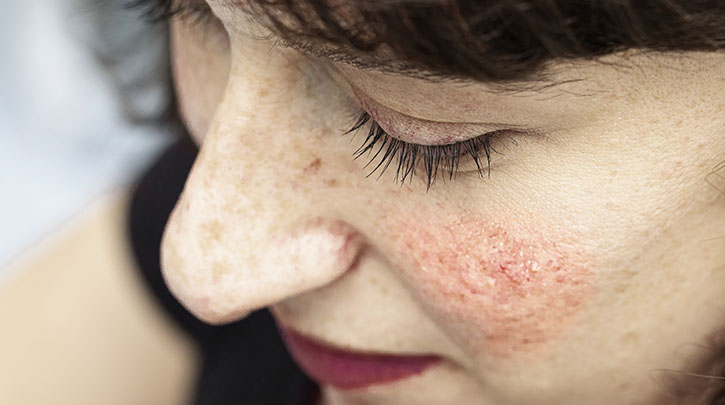
- United States
Get non-surgical solutions for today's top aesthetic concerns with Venus Treatments. Join thousands of satisfied patients worldwide!
- Loading...
- All Regions
Get non-surgical solutions for today's top aesthetic concerns with Venus Treatments. Join thousands of satisfied patients worldwide!

Rosacea is one of the primary skin concerns for North Americans today, impacting approximately 16 million people in the United States alone, according to the American Academy of Dermatology Association. While it most commonly affects women between the ages of 30-50, men and people of all ages can fall subject to this chronic condition, regardless of skin color.
Rosacea typically shows up without warning, though there are some external factors that are known to trigger rosacea, such as too much sun exposure and certain medications including steroids. Research shows that people with fair skin, and people of northern or eastern European descent, can also be at greater risk of developing rosacea.
Though there’s no cure for rosacea at the moment, the good news is that highly effective treatment options are available. In order to get the best treatment plan in place for your skin, it’s important to know how to speak to your doctor about it.
Before speaking to your doctor, it might help to recognize the symptoms of rosacea so you can communicate your personal skin troubles. Those affected by rosacea know that a particularly frustrating component of the condition is that it affects the most visible part of you—your face. As a result, it can lead to not only physical discomfort but also in a loss of confidence and self-esteem for those who have it.
Most people equate rosacea with red, inflamed skin, usually confined to the cheeks—but the truth is much more complicated than that. Rosacea symptoms can manifest in many different ways, and red, patchy skin is only one of them. If you are experiencing any of the following, then you may be suffering from rosacea: inflammation, visible blood vessels, enlarged pores, uneven texture, bumpy or thickened skin, red bumps, and/or an itching or burning sensation. The area of the face most commonly affected are the cheeks, forehead, chin, and nose, but in rare instances the eyes can be afflicted as well.
The first step when dealing with any sort of skin trouble is getting it properly diagnosed. Begin by telling your family doctor about your concerns so they can refer you to a dermatologist. A dermatologist will be able to address your skin issues from a health perspective, as well as an aesthetic one. Because your skin is different every day due to fluctuating hormones, environmental factors, and other stressors, make sure to come to the appointment with a thorough list of the symptoms you’d like to see treated. A journal can come in handy for this; jot down a few notes to yourself about your skin every day for a month. You might be surprised how well it helps you remember details so you can provide your dermatologist with a complete picture.
Once your healthcare professional has a general assessment of your condition, they can help you work up a plan to treat your rosacea. This might include lifestyle changes, topical applications, or prescription medication. Some people find that It’s important to note that these kinds of treatments can take up to six months or longer to take effect. Luckily, there are more immediate treatment options that deliver noticeable results, while still being non-invasive.
Recent innovations in medical aesthetics mean that you can now reduce and even eliminate the signs of rosacea quickly and painlessly. There are two aesthetic treatment options, in particular, that will improve the appearance of the skin while reducing symptoms: skin resurfacing and photofacial.
Venus Concept’s skin resurfacing treatments are an effective way to safely reduce the enlarged pores and uneven skin texture that are most often brought on by rosacea. The Venus Viva™ uses NanoFractional RF (radio frequency) targets the collagen and elastin fibers beneath the skin’s surface, kickstarting its natural healing process. The sessions last 15-30 minutes, with no downtime, and many people see visible results after only one session.
Similarly, photofacial treatments can improve the red, inflamed facial skin that most rosacea sufferers would love to get rid of. The SmartPulse™ technology of the Venus Versa™ uses Intense Pulsed Light to diminish vascular marks, such as visible veins, without damaging surrounding tissue. Like our skin resurfacing treatments, a Venus Versa™ treatment delivers noticeable results in a short time and is completely non-surgical.
When it comes to choosing the right aesthetic treatments for your unique skin concerns, a qualified treatment provider is your best friend and your first line of defense. They’ll create a treatment plan for you to ensure the best results, guiding you every step of the way on your path to smooth, clear, rosacea-free skin. To begin the process of reversing and managing your rosacea symptoms, contact a certified treatment provider near you using the search below.
Find a certified Venus Treatments provider near you today who specializes in today’s top aesthetic medical solutions.

Search below to find a provider near you and to learn about our non-surgical aesthetic treatments with ARTAS®, NeoGraft®, Venus Bliss™, Venus Bliss MAX™, Venus Versa™, Venus Legacy™, Venus Velocity™, Venus Viva™ MD, and Venus Glow™.
For more information call: (888) 907-0115 // [email protected] // 4001 SW 47th Ave, Suite 206, Davie, Florida, 33314
REGULATORY CLEARANCES [ More ]
Venus Bliss™ is cleared by the FDA for non-invasive lipolysis of the abdomen and flanks in individuals with a Body Mass Index (BMI) of 30 or less, with the diode laser applicators. The (MP)2 applicator is cleared by the FDA for temporary reduction in the appearance of cellulite.
Venus Versa™ is cleared by the FDA as a multi-application device intended to be used in aesthetic and cosmetic procedures. The SR515 and SR580 applicators are cleared by the FDA for the treatment of benign pigmented epidermal and cutaneous lesions and treatment of benign cutaneous vascular lesions. The HR650/HR650XL and HR690/HR690XL applicators are cleared by the FDA, for the removal of unwanted hair and to effect stable long-term or permanent hair reduction for Fitzpatrick skin types I-IV. The AC Dual applicator is cleared by the FDA for the treatment of acne vulgaris. The DiamondPolar™ and OctiPolar™ applicators on the Venus Versa™ system are cleared by the FDA for non-invasive treatment of moderate to severe facial wrinkles and rhytides on females with Fitzpatrick skin types I-IV. The NanoFractional RF™ applicator is cleared by the FDA for dermatological procedures requiring ablation and resurfacing of the skin.
NeoGraft® is cleared by the FDA with indication for use in suction-assisted follicular extraction and re-implantation. NeoGraft® is an auto-graft system and can be used on both male and female patients.
ARTAS iX™ is cleared by the FDA with indication for use for harvesting hair follicles from the scalp in men diagnosed with androgenic alopecia (male pattern hair loss) who have black or brown straight hair. ARTAS iX™ is intended to assist physicians in identifying and extracting hair follicular units from the scalp during hair transplantation; creating recipient sites; and implanting harvested hair follicles.
Venus Legacy™ is cleared by the FDA for the non-invasive treatment of moderate to severe facial wrinkles and rhytides in females with Fitzpatrick Skin Types I-IV with the OctiPolar™ and DiamondPolar™ applicators, and temporary reduction in the appearance of cellulite with the 4D Body (LB2) and 4D Face (LF2) applicators.
Venus Velocity™ is cleared by the FDA for hair removal, permanent hair reduction (defined as the long-term stable reduction in the number of hairs re-growing when measured at 6, 9 and 12 months after the completion of a treatment regimen), and the treatment of pseudofolliculitis barbae for all Fitzpatrick skin types.
Venus Viva™ is cleared by the FDA for dermatological procedures requiring ablation and resurfacing of the skin. The DiamondPolar™ applicator is cleared by the FDA for the treatment of moderate to severe wrinkles and rhytides in Fitzpatrick skin types I-IV.
Venus Freeze Plus™ is cleared by the FDA for the non-invasive treatment of moderate to severe facial wrinkles and rhytides in Females with Fitzpatrick skin types I-IV.
Venus Heal™ is cleared by the FDA for the relief of minor muscle aches and pain, relief of muscle spasm, and temporary improvement of local blood circulation. These indications enable the treatment of certain soft tissue injuries and conditions.
Venus Freeze™ is cleared by the FDA for the non-invasive treatment of moderate to severe facial wrinkles and rhytides in Females with Fitzpatrick skin types I-IV.
Venus Glow™ is cleared by the FDA as a Class I motorized dermabrasion device. It provides a dermal rejuvenation treatment that works to open up and deep-clean pores. Venus Concept is the exclusive distributor for Venus Glow™.
Venus Swan™ is cleared by the FDA for the non-invasive treatment of moderate to severe facial wrinkles and rhytides.
Copyright © 2025 Venus Concept. All rights reserved.
You are entering our website. For other countries/regions and language options, please click the SELECT A DIFFERENT REGION button below.
SELECT A DIFFERENT REGIONAre you looking to get a treatment? Please visit our patient website to learn more.
Click HereUnsure which aesthetic treatment is right for you? Take this quick and easy quiz to discover treatments that suit your needs.
Get Started